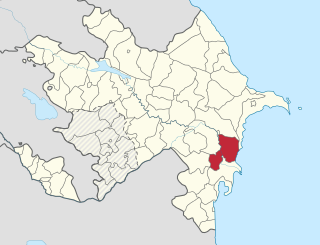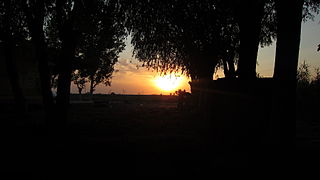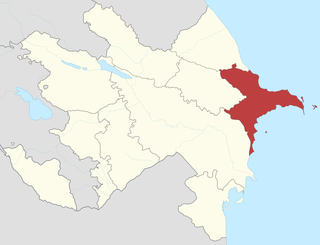
Agsu is an administrative district in central Azerbaijan.

Goychay is a region of Azerbaijan located in the central part of the country. The region is famous for its pomegranate growing industry, and for its pomegranate festival.

Hajigabul is one of the districts of Azerbaijan established in 1990 by the decision of the Supreme Council of the Republic. The district is bordered by Absheron, Gobustan, Shamaxı, Aghsu, Kurdamir, Sabirabad, Salyan, and Shirvan city.

Kurdamir district - administrative and territorial unit in the Republic of Azerbaijan. Founded in 1930 as the center of the Aran economic region. It is located on the Shirvan plain. Kurdamir is bordered by Hajigabul and Sabirabad in the east, Imishli from the south, Zardab, Ujar and Goychay in the west, and Ismayilli and Aghsu in the north. The area is 1631.5 km², the population is 115.6 thousand people (01.01.2018). The capital of the district is Kurdamir.

Salyan is a raion of Azerbaijan. Its capital is Salyan. It lays adjacent to the Kura River. To the north are several productive oilfields operated by the Salyan Oil company. It also comprises most of the Shirvan National Park.

Kürdəmir is a town in and the capital of the Kurdamir Rayon of Azerbaijan. It is located in Aran economic region of Republic of Azerbaijan. The district shares borders with Hajigabul and Sabirabad in the east, Imishli from the south, Zardab, Ujar and Goychay in the west, and Ismayilli and Aghsu in the north.

Shamakhi is the capital of the Shamakhi District of Azerbaijan. The city's estimated population as of 2010 was 31,704. It is famous for its traditional dancers, the Shamakhi Dancers, and also for perhaps giving its name to the Soumak rugs.
Fauna of Azerbaijan or animal kingdom of Azerbaijan refers to the diversity of various types of animals, which inhabit and populate a defined ground or water area in Azerbaijan.

The following outline is provided as an overview of and topical guide to Azerbaijan:

Agsu is a city in and capital of the Agsu Rayon of Azerbaijan.

Tourism in Azerbaijan has been an important sector of the Azerbaijani economy since the 1990s. According to Azerbaijan's Center for Economic and Social Development, the country is in 39th place among 148 countries in tourism competitiveness indicators. The World Travel and Tourism Council reported that Azerbaijan is among the top ten countries with the greatest increase in visitor exports from 2010 to 2016. The country had the world's fastest-developing travel and tourism economy in 2017. To promote tourism, Azerbaijan sponsored Atlético Madrid jerseys reading "Azerbaijan – Land of Fire". In 2018 new tourism brend and slogan "take another look" were introduced.
The Azerbaijan Rural Investment Project (AzRIP) was established by the government of Azerbaijan’s State Agency on Agricultural Credits under the Azerbaijan Ministry of Agriculture. It is designed to invest in the rural development of five economic regions of Azerbaijan, focusing on community-based infrastructure development.

The Absheron Economic Region is located in the eastern part of the Republic of Azerbaijan and comprises Baku and Sumgait cities and the Absheron and Khizi districts. The eastern part of the economic region is located on the shores of the Caspian Sea, which has positive effects on the economy of the region.

Topaz is a bookmaker in Azerbaijan.

Shaki-Zagatala economic region is one of the 10 economic regions of Azerbaijan. It borders Dagestan, Russia, to the north, Georgia to the west, and Ganja-Gazakh, Aran, Mountainous Shirvan, Guba-Khachmaz economic regions to the south and east. Region consists of Balakan, Zagatala, Gakh, Shaki, Oghuz and Qabala administrative districts. Other than the 6 districts, there are also 6 cities, 8 settlements, 336 villages and 181 municipalities in the economic region. Municipal elections are held by voting.
The Azerbaijan is a country with very favorable natural conditions and rich natural resources. Snowy peaks, high mountains, foothill fertile soils, wide plains, Lowest Land Points Below Ocean Level are the main landscape forms of republic. This complex landscape structure has caused the variety in natural conditions - climate, soil-vegetation, and water resources. This, in turn, led to the uneven distribution of population and farms on the territory, and the specialization of production on different types.
National Policy Dialogues on Integrated Water Resources Management in Azerbaijan for managing water resources are aimed at developing a state strategy based on "Convention on the Protection and Use of Transboundary Watercourses and International Lakes” of United Nations Economic Commission for Europe and European Union Water Framework Directive and the “Water and Health” Protocol of that convention as well as other principles of the United Nations and the EU.

Guba is a district found along the Guba-Khachmaz economic region spanning 7.66 thousand km2 in the north-east of Azerbaijan. The currency of Azerbaijan is the manat. The region is rich with natural resources, including natural gas, oil, sand, gravel and combustible shale.
The silk industry in Azerbaijan has existed since ancient times. Shirvan was the largest silk farming region there. The population in Shamakhi, Basqal, Ganja, Shaki and Shusha engaged in silk production. Patterned, ornamental silk female kerchiefs were produced in these regions. Silk production was one of the main activities continued into modern times.

Aran economic region is one of the Azerbaijani economic regions.















